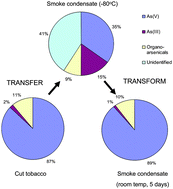The efficiency of a sequential extraction procedure (leaching with water followed by extraction with driselase and sodium dodecylsulfate) was investigated for quantitative As speciation in cut tobacco by HPLC-ICP-MS. The total As concentration and size-exclusion HPLC-ICP-MS profiles obtained for the extracts were used to select optimal extraction conditions as a trade-off between As extraction efficiency and preservation of compound identity. Leaching the cut tobacco (taken from 3R4F Kentucky research reference cigarettes) with water by either sonication in a water bath for 2 h or microwave-assisted extraction (MAE) at 50 W (50 °C) for only 10 min enabled approximately 42% of the total As in the solid to be extracted. Using anion-exchange HPLC with ICP-MS detection, 89% of the total water-soluble As was, for the first time, reported to be present as inorganic As. The instrumental limits of detection (3σ criterion) obtained for arsenite and arsenate by anion-exchange HPLC-ICP-MS were 10 and 50 ng kg−1 As, respectively. Using this hyphenated method, the presence of DMA and MMA as minor As species in the water-soluble fraction could also be detected. Complementary cation-exchange HPLC-ICP-MS analysis of unspiked extracts and extracts spiked with As standards pointed to the presence of arsenate (as a major As species) and DMA and MMA (as a minor As species). Interestingly, recent XANES results revealed that the cut tobacco contained almost exclusively As(V). Successive extractions with driselase and sodium dodecylsulfate (SDS) on the solid residue led to further extraction of approximately 13% and 8%, respectively, of As from the solid cut tobacco. The total As concentration in a homogenate of cut tobacco (from 3R4F Kentucky reference cigarettes) was found to be 318 ± 9 ng g−1 As (precision as SD, n = 3), as determined by microwave acid digestion followed by collision reaction cell ICP-MS (He mode) with standard addition calibration. The developed hyphenated MS methodology was used to study the speciation of As in water-soluble extracts of 3R4F mainstream smoke. These extracts were, for the first time, found to contain arsenite (As(III)), arsenate (As(V)) and an unidentified As-containing species. XANES analysis also reported a mixture of As(V) and As(III) in mainstream cigarette smoke condensate. The reduction of As(V) to As(III) during dynamic cigarette smoke formation can be explained by the overall smoke redox properties associated with the cigarette combustion process.

You have access to this article
 Please wait while we load your content...
Something went wrong. Try again?
Please wait while we load your content...
Something went wrong. Try again?


 Please wait while we load your content...
Please wait while we load your content...